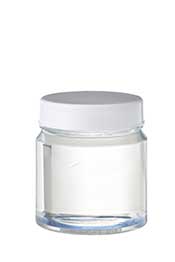
Over the past decade, coconut oil has skyrocketed in popularity as the negative myths surrounding saturated fat subside.
However, there’s a particular type of cooking oil on the shelves that you may not know about: fractionated coconut oil.
This article looks into precisely what fractionated coconut oil is, how it compares to regular coconut oil, and whether it’s good or bad for you.
What is Fractionated Coconut Oil?
Firstly, alongside red palm oil and palm kernel oil, coconut oil is one of the three popular tropical oils. It grows in the Americas, Africa, and certain parts of South and South-East Asia.
However, there are many different types of coconut oil, and several of these are known as fractionated coconut oil.
Generally speaking, fractionated coconut oils remove most of the long-chain fatty acids (LCFAs) through a process called “fractionation.”
As a result, they predominantly consist of medium-chain fatty acids (MCFAs).
We can find three types of fractionated coconut oil;
- Fractionated coconut oil: this oil takes the name of the production process. It is not food grade, and it’s selling for external use.
- Liquid coconut oil: this is an edible oil for cooking, and it’s also suitable for external use.
- MCT oil (Medium-Chain Triglycerides): Similar to liquid coconut oil but this only contains two medium-chain fatty acids – capric and caprylic acid.
There are also other variants of MCT oils which contain specific single medium-chain fatty acids.
Unlike virgin coconut oil, all fractionated coconut oils are refined (i.e. they are man-made in a factory).
As mentioned, they primarily contain MCFAs, while regular coconut oil contains both MCFAs and LCFAs.
The table below shows the different fatty acid compositions for coconut oil (CO) and fractionated coconut oil (FCO);
| Fatty Acid | CO | FCO |
| Arachidic acid (long-chain) | MINIMAL | |
| Capric acid (medium-chain) | LOW | HIGH |
| Caproic acid (short-chain) | MINIMAL | |
| Caprylic acid (medium-chain) | LOW | V. HIGH |
| Lauric acid (medium-chain) | HIGH | LOW |
| Linoleic acid (long-chain) | MINIMAL | |
| Myristic acid (long-chain) | MEDIUM | |
| Oleic acid (long-chain) | LOW | |
| Palmitic acid (long-chain) | MEDIUM | |
| Stearic acid (long-chain) | LOW |
The two major fatty acids in all fractionated coconut oils are the MCFAs capric acid and caprylic acid.
Notably, lauric acid—the most important fatty acid in regular coconut oil—is only present in small concentrations.
Regular coconut oil is approximately 92% saturated fat, whereas fractionated coconut oils are fully saturated.
How is Fractionated Coconut Oil Made?

You may have noticed the form coconut oil takes depends on the current temperature.
This is because it has a melting point of 24°C (76°F), so unless you are lucky enough to live in a tropical climate, coconut oil will change depending upon the season (1).
As the winter approaches, coconut oil will be a solid cloudy white color at room temperature.
However, on a hot summer’s day, that same oil will become a clear liquid.
Since every fatty acid contained within coconut oil has a slightly different melting point, it is possible to separate each one.
This separation sums up the definition of fractionation; separating the constituents of a gas or a liquid.
The fractionation process starts off by heating regular coconut oil to its melting point.
When the coconut oil reaches its melting point, it becomes a liquid state. After cooling, individual fatty acids such as lauric acid and the LCFAs will re-solidify at a quicker pace than the MCFAs.
As a result, we can then separate these solid fatty acids from the rest of the oil.
Doing this leaves a coconut oil composing of mainly MCFAs, and we can call this fractionated coconut oil.
Differences Between Coconut Oil and Fractionated Coconut Oil
Here is a quick run-down of how regular and fractionated coconut oils compare;
| Property | Coconut Oil | Fractionated Coconut Oil |
| Production | Cold-pressed or refined | Refined |
| MCFAs | 64% | 100% |
| LCFAs | 35% | 0% |
| SCFAs | <1% | 0% |
| Saturation | 92% | 100% |
| Melting Point | 24°C / 76°F | -4°C / 25°F |
| Smoke Point | 177°C / 350°F | 160°C (320°F) |
| Other Names | Cold-pressed coconut oil Virgin coconut oil Extra virgin coconut oil EVOO Refined coconut oil |
Liquid coconut oil MCT oil |
| Main Fatty Acid | Lauric Acid | Caprylic Acid |
Why Are MCFAs Beneficial?

Firstly, the body doesn’t metabolize medium-chain fatty acids in the same way as it does long-chain fats.
Similar to how fiber is different from most carbohydrate and doesn’t digest into glucose, MCFAs also have a different digestive pathway.
Notably, they do not require bile salts for their digestion. After we consume MCFAs, our body takes them directly to the liver from the gastrointestinal tract.
Upon arrival, they are converted into instant energy to fuel the body (2).
As a result of this unique pathway, MCTs have a wide variety of research behind them as a potential weight loss tool.
Health Benefits
Research shows some significant benefits of consuming fractionated coconut oil.
These include;
- Weight loss
- Impact on insulin resistance
- Easy digestibility
- Maintaining brain health and treating brain conditions
- An instant source of energy
- Antioxidant properties
Weight Loss
- In calorie-controlled diets, several studies show that MCTs resulted in less fat storage than olive oil, soybean oil, and rapeseed oil (3, 4, 5).
- Thirteen randomized controlled trials show that dietary medium-chain fats result in greater weight loss than long-chain fats (6).
- MCTs “increase fat oxidation and energy expenditure, reduce food intake and beneficially alter body composition” (7).
- Several studies show that MCTs increase satiety and can potentially lead to a reduced food intake (8, 9, 10).
Insulin Resistance
- Several studies indicate that medium-chain fatty acids help to improve insulin sensitivity and decrease risk factors for insulin resistance (11, 12).
Easy Digestibility
- Unlike other dietary fats, MCTs do not require any complex digestion process. They are converted into almost instant energy via the liver and are therefore much easier to digest (13, 14, 15).
Brain Health
- MCFAs—especially caprylic acid—have evidence showing they can play a significant role in the management of epilepsy. In fact, several studies indicate that supplementation with MCT oil significantly improves epileptic seizure control (16, 17, 18).
- There is some degree of evidence that MCFAs may also play a beneficial role in the treatment of Alzheimer’s disease (19, 20, 21).
Instant Energy
- As MCFAs convert to energy without requiring digestion by bile acids, they may hold benefits for sporting performance. However, the studies are a mixture of positives and negatives (22, 23, 24).
- One study concludes that MCT oil has poor efficiency and that it is “not superior to carbohydrate supplementation (25).
Other
- Fractionated coconut oils have a longer shelf life, and they are more resistant to oxidation. This is partly due to their higher level of saturated fats compared to regular coconut oil.
Drawbacks

While fractionated coconut oil has benefits relating to the compounds it does contain, there is a notable fatty acid missing.
There are also some potential side effects.
Lauric Acid
In particular, MCFAs contain virtually no lauric acid – one of the most beneficial fatty acids in coconut oil.
Coconut is the most significant source of lauric acid in the world, with only human breast milk coming anywhere close.
However, while coconut oil contains 50% lauric acid by volume, fractionated coconut oil only contains lauric acid in single-digit amounts.
Numerous studies show that lauric acid has some substantial health benefits;
- Lauric acid is known to have antibacterial, antimicrobial and antiviral properties (26, 27, 28, 29).
- While lauric acid increases total cholesterol, the most significant rise occurs in HDL, and it positively affects the overall LDL/HDL ratio. Higher HDL levels are associated with reduced cardiovascular risk (30, 31).
- Lauric acid can be used externally to treat acne or inflammatory skin conditions due to its strong antibacterial properties (32).
Side effects
Unfortunately, MCT oils have some documented side effects in certain individuals.
These mainly involve gastrointestinal complaints such as (33, 34);
- Bloating
- Cramping
- Diarrhea
- Nausea
- Vomiting
However, they are rare, and it appears that they only occur when consuming large amounts of MCFAs.
Expense
Another key point to look at is the cost of fractionated coconut oils; approximately double the price of regular coconut oil.
Uses of Fractionated Coconut Oil

There is a wide range of uses for all three types of fractionated coconut oils.
It’s worth remembering that these are all similar, and you can probably use each in the same way without worry.
But for the purpose of this article, the uses match the different product names;
Fractionated Coconut Oil
The self-named product is intended for external use for beauty and skin health maintenance.
It is possible to use the oil as;
- Hair and skin moisturizer
- Shiner for hair and face
- Hair conditioner
- UV protection: coconut oil offers some (but minimal) protection from UV rays. However, it only has a very weak effect, and we shouldn’t rely on it for sun protection. Careful sun exposure and either seeking shade or using natural sunscreens are both better options to prevent burning.
Liquid Coconut Oil
Liquid coconut oil is intended for cooking purposes.
However, it’s important to note that it has a slightly lower smoke point than regular coconut oil does (160°C compared to 177°C).
(See this guide to deep-frying oils for the best high-heat cooking options.)
If you specifically want a cooking oil, it would be better (and cheaper) just to stick to extra virgin coconut oil.
MCT Oil

MCT oil is not intended for cooking or external use.
This oil is promoted as a supplement to gain higher amounts of medium-chain fatty acids in the diet.
It has also received a lot of attention due to its use in Bulletproof Coffee.
If you want more MCFAs in your diet, then MCT oil is the best (but not the cheapest) option.
Final Thoughts
What kind of fractionated coconut oil is the best?
That really depends on what you want it for.
Do you want to consume more MCFAs in your diet for medical reasons? Or perhaps to test the supposed weight loss benefits? In that case, MCT oil is likely the best choice.
On the other hand, if you want it for beauty and skin care purposes, then go with the fractionated coconut oil.
Lastly, unless there’s any special reason why you need a higher amount of MCFAs, then I’d just use regular coconut oil.
It’s cheaper and a lot less processed.
Additionally, it contains all the beneficial fatty acids that exist in a real coconut – something that fractionated oils can’t claim.
For more on heat-stable cooking oils, see this review of macadamia nut oil.

I have read conflicting information re: the type of oil that has antibacterial properties–this is the first time I’ve seen it laid out like this. So–for antibacterial purposes–regular, unrefined coconut oil is best because of Laurie acid, right?! I had read it was the MCT that made coconut oil antibacterial–but that is wrong? Does “MCT Oil” offer any antibacterial benefit? Thanks!
Yes, that’s right! Lauric acid is behind the purported antibacterial properties, and MCT oil does not contain this.
According to the research, the other MCT oils also have slight antibacterial properties, but lauric acid is really the standout.
Really helpful post. Thanks for the information. It is rare to see such an honest post.
Thanks, Mayur!